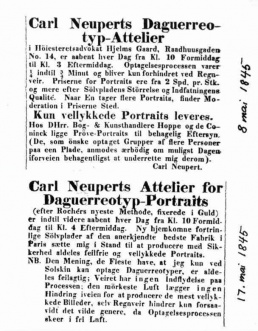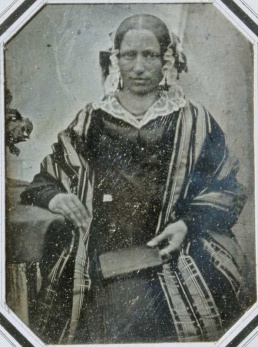Difference between revisions of "Media technology in Norway"
(Created page with "==Lithography== [[Image:Fehr_Gottlieb_Louis_c1830_Kongsberg_lithography.jpg|thumb|258px|A lithography of Kongsberg produced in Fehr's workshop, drawn by Clausen, c1830. [http:...") |
|||
| Line 57: | Line 57: | ||
* Jonas Ekeberg, Harald Østgaard Lund, ''80 millioner bilder - Norsk kulturhistorisk fotografi 1855-2005'', Forlaget, 2008, 343 pp. (in Norwegian) [http://fpress.no/index.php?ID=Bok&counter=179], [http://www.mediepedagogene.no/wp-content/uploads/Norsk-fotohistorie.pdf Review]. | * Jonas Ekeberg, Harald Østgaard Lund, ''80 millioner bilder - Norsk kulturhistorisk fotografi 1855-2005'', Forlaget, 2008, 343 pp. (in Norwegian) [http://fpress.no/index.php?ID=Bok&counter=179], [http://www.mediepedagogene.no/wp-content/uploads/Norsk-fotohistorie.pdf Review]. | ||
* CecilieTyri Holt, ''Edvard Munchs fotografier'', Forlaget, 2013. (in Norwegian) | * CecilieTyri Holt, ''Edvard Munchs fotografier'', Forlaget, 2013. (in Norwegian) | ||
| + | |||
| + | ==Sound recording== | ||
| + | [[Image:Peder_Larsen_Dieseth_tinfoil_recording_1879_Oslo.jpg|thumb|258px|Dieseth's tinfoil recording, 1879. [http://eprints.soton.ac.uk/152891/1/JTS2010_-_Norwegian_artefact_scanning_PJB_laga.pdf] ]] | ||
| + | [[Image:Playing_phonograph_1890s_Tonstad.jpg|thumb|258px|Listening to phonograph during a cattle show in Tonstad in Vest-Agder, 1890s. [http://www.nb.no/nbsok/nb/e8642bf6b53e56ce783577a57575dbfd#15] ]] | ||
| + | <blockquote>{{#widget:Html5media|url=http://www.tekniskmuseum.no/images/audio/tinnfolie.mp3|width=350|height=0}}<br><br><br> | ||
| + | The oldest preserved sound recording made in Norway, 1879. | ||
| + | </blockquote> | ||
| + | * A sound recording on tinfoil was made by the music retailer Peder Larsen Dieseth using Edison phonograph on 5 February 1879 at the Tivoli in Oslo. In 1934 Dieseth donated it to the National Museum of Science and Technology, and in 2009 it was digitised by the Research Institute for Industry at the University of Southampton; the recovery process is [http://eprints.soton.ac.uk/152891/1/JTS2010_-_Norwegian_artefact_scanning_PJB_laga.pdf described here]. [http://www.tekniskmuseum.no/utstillingene/aktuelle-utstillinger/348-juni-09-musikkmaskiner] [http://www.nrk.no/programmer/radio/norgesglasset/1.6678705] | ||
| + | * The first gramophone disc in the country was recorded in December 1904 at the Grand Hotel in Oslo. The entertainer Adolf Østbye sang the song ''Bal i Hallingdal'' with Carl Mathisen on accordion. The disc is part of the Teknisk Museum's collection. [http://www.nb.no/nasjonenshukommelse/category/musikk/?nr=391] [http://www.ballade.no/nmi.nsf/doc/art2005060909593673142137] [http://www.ballade.no/nmi.nsf/doc/art2005060911042237544518] | ||
| + | |||
| + | ; Literature | ||
| + | * Ivar Roger Hansen, Per Dahl (eds.), ''Verneplan for norske lydfestinger'', Norsk lydinstitutt, 1997. [http://www.digi.no/45882/verneplan-paa-nett] | ||
| + | * Vidar Vangberg, ''[http://www.nb.no/nbsok/nb/e8642bf6b53e56ce783577a57575dbfd Norsk lydhistorie, 1879-1935: Historikk og veiledning i innsamling, registrering og anvendelse av historiske lydsamlinger]'', Oslo: Nasjonalbiblioteket, 1999, 87 pp. (in Norwegian) | ||
| + | * Vidar Vangberg, ''Da de første norske grammofonstjernene sang seg inn i evigheten: Norsk grammofonhistorie 100 år'' Oslo: Nasjonalbiblioteket, 2005, 186 pp. (in Norwegian). With a CD containing 25 recordings, mostly from the years 1904-05. [http://www.ballade.no/nmi.nsf/doc/art2005060911042237544518] | ||
| + | * Hans Fredrik Dahl, Henrik Grue Bastiansen, ''Norsk mediehistorie, Vol. 2'', 2008, 608 pp. (in Norwegian) [http://www.universitetsforlaget.no/nettbutikk/boker%7C%7Cmediefag%7C%7Cnorsk-mediehistorie-2-utgave.html] | ||
| + | * Thomas Bårdsen, ''[http://brage.bibsys.no/hinesna/retrieve/537/Masteroppgave%20Thomas%20B%C3%A5rdsen%20-%20Fra%20evig%20is%20til%20evig%20tid.pdf Fra evig is til evig tid. Bevaring av 100 år gamle lydopptak, for de neste 1000 år]'', Nesna, 2010. Master's Thesis. (in Norwegian) | ||
==See also== | ==See also== | ||
* [[Norway]] | * [[Norway]] | ||
Revision as of 17:40, 20 September 2013
Contents
Lithography


After short-lived lithographic practice in Copenhagen and Stockholm, the German portrait painter and draftsman Louis (Friedrich Ludwig) Fehr and his son Gottlieb Louis moved to Oslo in October 1822 and started there the first lithographic printing house in the country. The company produced portraits of famous contemporaries, sheet music, illustrations for scientific publications of the University, administrative business forms (letterheads, invoices, exchange and lending documents), etc. Despite his growing business, Louis Fehr left Norway for Germany in Autumn 1824, and the company was taken over by his other son Carl Louis. [10] [11]
The bookseller Hans Thøger Winther, originally from Denmark (see below), opened his lithographic workshop in Oslo in 1823, and quickly became known for his extensive and varied production. He published portraits of famous Norwegians, landscapes and town prospects and lithographs of the Constitution. His large prospect of Oslo from 1835 provides an excellent view of the city and a number of important buildings. [12] [13]
Georg Prahl (Georg Carl Christian Wedel Prahl) opened a lithographic workshop in Bergen from Autumn 1828. He printed portraits, prospects, sheet music, maps, or a popular school atlas (1836). In connection with lithographs of national and peasant costumes he worked with artists such as Jacob Mathias Calmeyer, Joachim Frich, JFL Dreier and Hans Leganger Reusch. Between 1852–55 he served as chairman of Bergen Art Association [Bergens Kunstforening]. [14] [15]
Among more known painters, Erik Werenskiold, Edvard Munch (from 1894) and Henrik Sørensen worked with lithography. [16]
There are several lithographic workshops operating in Norway today. Grafisk Stentrykk in Oslo was established in 1991 and has two large 'snellpresser' automatic printing machines as well as possibilities for hand press-printing, intaglio printing (photogravure), and die stamping.
Photography





Photographers
- Hans Thøger Winther was born in Thisted in the north of Denmark, and moved to Oslo in 1801 where he opened a book and music store [Boghandling [17] ] in his house in 1822, lithographic printing house [Steentrykkeri [18] ] in the basement in 1823, rental book library in 1825, book publishing house [Bogtrykkeri [19] ] in 1827, and published several magazines. He was making photographs between 1839 and 1851, as a hobby, never opening a studio. He had heard of Daguerre's discovery in 1839 and without knowing the details experimented with three techniques, direct positive on paper, negative/positive, and diapositive (it is not known that this technique was utilized in photography elsewhere). In 1842 he switched to using paper negatives. Wrote articles on photography as early as October 1839, and the first Norwegian handbook of photography, Anviisning til paa trende forskjellige Veie at frembringe og fastholde Lysbilleder paa Papir, published in 1845. [20] [21] [22]
- O.F. Knudsen was photographing in Oslo in 1840-61. [23]
- Carl Cetti Bendixen from Hamburg worked as daguerreotypist in Bergen in 1843. [24]
- Carl Stelzner, portrait painter and daguerreotypist with a studio in Hamburg, with many Norwegians among his students. He shortly worked in Oslo in August 1843. [25]
- Carl Neupert, student of Steltzner in Hamburg, ran his studio in Oslo from 15 May 1844 until 1846. He was also active in Kristiansand (1844), Trondheim (1844), Bergen (1844), St. Petersburg (1847), and in Helsinki and other locations in Finland (1848-49). [26] [27] [28]
- Frederik Ulrik Krogh showed a daguerreotype depicting Barrière de la Chapelle in Paris in the Bergen Art Association already in 1840. He worked in Bergen (1844-48) and Stavanger (1844-45). [29]
- Marcus Selmer from Denmark had his studio in Bergen from 1852 until his death in 1900. [30] [31] [32] [33] [34] [35]
- Knud Knudsen, learnt photography probably from Selmer in Bergen in the late 1850s, and ran his studio there from 1864 to c1915. [36] [37] [38] [39] [40] [41] [42] [43] [44]
- Anders Beer Wilse created massive photodocumentation of Norway in the first half of the 20th century. [45] [46] [47] [48] [49]
Events
- On 4 February 1839, Den Constitutionelle newspaper reported about Arago's speech in Paris from 7 January.
- October 1840, daguerreotype exhibition in Bergen.
- New Year of 1841, daguerreotype exhibition at Christiania Art Society [Christiania kunstforening], Oslo.
- Norsk fotohistorie – frå daguerreotypi til digitalisering exhibition, Preus museum, 2007. [50]
Resources
- Fotoregistrene [Photo Register], a database of photographers and photo collections/archives in Norway, started in 1992-93, ran by The National Library together with Preus Museum.
- DigitaltMuseum, contains historical photographs fotografier, artifacts, art, altogether more than a million items.
- OsloBilder hosts scans of ten daguerreotypes.
- Other resources.
Preservation
- Fotonettverket [Photography Network], national network for the preservation and dissemination of vernacular photography, includes more than twenty museums, archives and libraries.
Literature
- Ragna Sollied, Eldre bergenske fotografer, Bergen: Eget forlag, 1967. (in Norwegian)
- Ragna Sollied, Eldre norske fotografer, Bergen, 1972. (in Norwegian)
- Susanne Bonge, Eldre norske fotografer. Fotografer og amatørfotografer i Norge frem til 1920, Bergen: Universitetsbiblioteket i Bergen, 1980, 533 pp. (in Norwegian) Contains information about 800 photographers.
- Roger Erlandsen, Vegard S. Halvorsen, Kåre Olsen, Inger Lise Rønning, Norske fotosamlinger 1989-90, Ad Notam Gyldendal, 1989, 232 pp. (in Norwegian)
- Robert Meyer, Den glemte tradisjonen. Oppkomst og utvikling av en nasjonal landskapsfotografi i Norge frem til 1914: en temautstilling fra Robert Meyers fotohistoriske samlinger i anledning av 150-årsjubileet for fotografi, Oslo Kunstforening, 1989, 91 pp. Catalogue. (in Norwegian)
- Oddlaug Reiakvam, Bilderøyndom – Røyndomsbilde: Fotografi som kulturelle tidsuttrykk Oslo: Samlaget, 1997. Dissertation. (in Norwegian)
- Liv Hausken, Om det utidige. Medieanalytiske undersøkelser av fotografi, fortelling og stillbildefilm, Institutt for medievitenskap, Universitetet i Bergen, 1998. Dissertation. (in Norwegian)
- Roger Erlandsen, Pas nu paa! Nu tar jeg fra Hullet! Om fotografiens første hundre år i Norge – 1839-1940, Inter-View & Norges fotografforbund, 2000, 323 pp. (in Norwegian) [51]
- Gunnar Iversen, Yngue Sandhei Jacobsen (eds.), Estetiske teknologier 1700-2000, Scandinavian Academic Press, Oslo, 2003. (in Norwegian) [52]
- Peter Larsen, Sigrid Lien, Norsk fotohistorie. Frå daguerreotypi til digitalisering, Oslo: Det Norske Samlaget, 2007, 344 pp. (in Norwegian) [53], Review, Review.
- Jonas Ekeberg, Harald Østgaard Lund, 80 millioner bilder - Norsk kulturhistorisk fotografi 1855-2005, Forlaget, 2008, 343 pp. (in Norwegian) [54], Review.
- CecilieTyri Holt, Edvard Munchs fotografier, Forlaget, 2013. (in Norwegian)
Sound recording


The oldest preserved sound recording made in Norway, 1879.
- A sound recording on tinfoil was made by the music retailer Peder Larsen Dieseth using Edison phonograph on 5 February 1879 at the Tivoli in Oslo. In 1934 Dieseth donated it to the National Museum of Science and Technology, and in 2009 it was digitised by the Research Institute for Industry at the University of Southampton; the recovery process is described here. [55] [56]
- The first gramophone disc in the country was recorded in December 1904 at the Grand Hotel in Oslo. The entertainer Adolf Østbye sang the song Bal i Hallingdal with Carl Mathisen on accordion. The disc is part of the Teknisk Museum's collection. [57] [58] [59]
- Literature
- Ivar Roger Hansen, Per Dahl (eds.), Verneplan for norske lydfestinger, Norsk lydinstitutt, 1997. [60]
- Vidar Vangberg, Norsk lydhistorie, 1879-1935: Historikk og veiledning i innsamling, registrering og anvendelse av historiske lydsamlinger, Oslo: Nasjonalbiblioteket, 1999, 87 pp. (in Norwegian)
- Vidar Vangberg, Da de første norske grammofonstjernene sang seg inn i evigheten: Norsk grammofonhistorie 100 år Oslo: Nasjonalbiblioteket, 2005, 186 pp. (in Norwegian). With a CD containing 25 recordings, mostly from the years 1904-05. [61]
- Hans Fredrik Dahl, Henrik Grue Bastiansen, Norsk mediehistorie, Vol. 2, 2008, 608 pp. (in Norwegian) [62]
- Thomas Bårdsen, Fra evig is til evig tid. Bevaring av 100 år gamle lydopptak, for de neste 1000 år, Nesna, 2010. Master's Thesis. (in Norwegian)